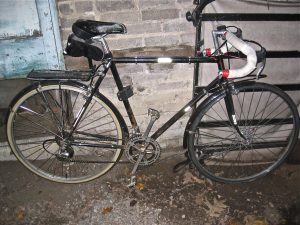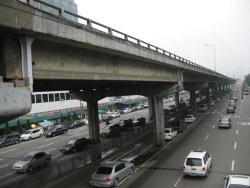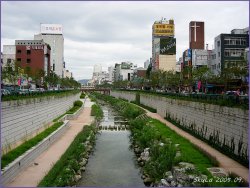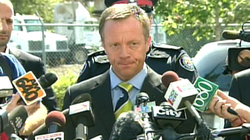
The judicial verdict is in on the sensational case of Michael Bryant. It sounds like a tragic case of a driver whose car’s stop/stall/roll action accidentally provoked an unstable bicycle courier, with tragic and ultimately fatal consequences. The driver appears to have behaved completely reasonably under the circumstances. The cyclist had a long history of aggressive confrontations and appears to have behaved in a threatening manner.
I take no issue with the facts of the case or the judgment. However, the incident has taken on large proportions in the media and the cycling community, and I find the official legal summary wanting in this regard. The crisp, neutral judicial language gives the document the air of Truth and Justice, when in fact it only represents The Law.
The document answers the legal problem at hand, a judgment on dangerous driving, and therefore focuses entirely on what constitutes “reasonable driver behaviour” under the circumstances. Lost in the context is what constitutes a reasonable cyclist’s reaction – and while the cyclist was not reasonable, an emotional reaction to having your rear wheel bumped is legitimate, and a subsequent furious reaction to being sent flying over the hood of the car is also fair. Because the document is necessarily focused on the Law, all such points on the public debate of cyclist/driver perspectives and emotions are out of the picture. Also lost in the discussion is any mention of the differences between car/car collisions from car/bike collisions – what may be a fender-bender in one context is an unnerving experience in the other, even if the vehicle doesn’t touch the cyclist’s skin, or if the vehicle is only going 13 km/h when it sends the cyclist flying over the hood.
The cycling community’s discontented reaction to the case stems from a desire for the driver world to “please understand our feelings!” Unfortunately, this particular cyclist’s aggressiveness makes it an unlikely to elicit any soul-searching. Note however the pattern: whether the cyclist is in the wrong (this case) or in the right (2008 story with a cyclist’s amputated leg), the cyclist will always be the one who gets injured or killed.
The morals: cyclists must hold their tempers, no matter the incident. And, there’s a profound lack of mutual understanding and respect still out there on the streets.
Category Archives: Transportation
Winter cycling, Dutch style
Growing up in Toronto, I was a six-month cyclist and six-month pedestrian/transit rider. Since moving back a few years ago, I’ve been shifting to closer to ten months of cycling. I realized that I feel much better when I get that daily exercise and sunshine, and it’s considerably faster for getting around, chaining trips and running errands.
In the process, I’ve been trying to find the right bike for the job, and have just bought a pricy Dutch bike for the coming winter. My summer bike is out of the question; it’s a nice bike, and far too vulnerable to the winter salt, grit and filth.
Bicycle #1. I bought this road bike at the nadir of my student bank balance for $100. It’s as old as I am and a little too small. It handled reasonably well on the winter streets, the narrow tires were good at punching through the snow to find pavement, and the vintage handlebar-end shifters were easy to use with big mitts. The caliper brakes are the deal-breaker though: quite weak in wet conditions, and so tight around the wheel that I can’t have both fenders and knobbly tires. I rode it over the two winters of 2006-2008, when I lived in an apartment building. In that building, I could use the underground parking garage for cleaning and regular maintenance, and the bike thawed overnight in slightly-above-zero conditions. Rusting was a major problem: a new chain and rear cluster every spring, often cables as well, and a lot of surface oxidization wherever the paint had chipped off.
Subcultures & cycling
The Copenhagenize blog has some interesting thoughts on cycling and subcultures: do the various cycling subcultures (racers, couriers, mountain bikers) in North America get in the way of making cycling appealing to normal citizens? The subcultures define themselves by gear or attitude – and I think this is quite offputting for normal people. It’s like a world where choosing to drive made everyone think you were a Formula One fan or a fix-your-own-car-guy. That said, the various European cycle chic blogs are perhaps guilty of pushing another subculture: beautiful people.
Google Map updates
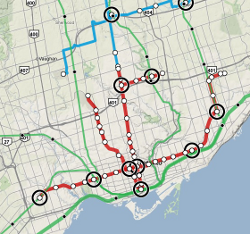 Several years ago, I put together some Google Maps for the Vancouver and Toronto transit systems. In light of the expected opening of the Canada Line in Vancouver on August 17th, I took a shot at updating the maps.
Several years ago, I put together some Google Maps for the Vancouver and Toronto transit systems. In light of the expected opening of the Canada Line in Vancouver on August 17th, I took a shot at updating the maps.
In the interim, though, Google has made some big advances in its handling of transit. They have a full database of rapid transit stops in Toronto (GO and TTC subway), and a layer that shows the TTC subway lines as well. York Region has provided Google with full local bus data, including schedules, and Google Maps does a fairly nice job of showing that information. That said, the visuals for the transit system aren’t the most attractive, the lines showing the GO rail network are hard to see, and other major transit facilities don’t jump out at the viewer (like the York VIVA BRT Light system or the Spadina streetcar). And in Vancouver, Google still has zero data.
So, my maps still serve a purpose. The changes in this edition are:
Greater Toronto Hamilton Area
- Added York VIVA Blue and Purple lines
- Changed Toronto colour scheme to colour code by operator (TTC, GO, VIVA) rather than by line. Changed line thickness to represent “all-day” vs. “peak only” service
- Added links to TTC and GO station websites
- The debate over “what to include on the map” is growing in my mind. Should St. Clair and Spadina be in, since they have partial segregation from traffic? Should the north half of VIVA Blue really be in, when it has 15 minute frequencies in the peak hour and operates in mixed traffic?
Metro Vancouver
- Removed 98 B-Line and moved Canada Line to the “present day” map. Updated Canada Line alignment, added numbers of connecting buses.
- Changed colours to match latest TransLink map, and changed line thickness to represent “all-day” vs. “peak only” service
Codebase
- Moved to more modern Google APIs now that they exist (e.g., GMarkerManager)
- Removed labels from map – the Toronto map in particular was far to cluttered, and the speed penalty for showing the labels was too high. They’re still there, but only if you move the mouse over a station icon.
Negawatts
I hope you don’t mind my descent into technobabble for a few moments.
The Toronto Star recently published an interesting article on demand management in the electricity sector in Ontario.
I go back to a speech that Paul Murphy, CEO of the Independent Electricity System Operator, gave back in January. He pointed out that of the 8,760 hours in all of 2006, peak electricity demand in the province only surpassed 25,000 megawatts for 32 hours. At its highest, it reached 27,005 megawatts last Aug. 1.
So we have two options: spend billions of dollars building and operating natural gas plants that can give us an extra 2,000 megawatts 32 hours of the year, or spend considerably less to pay companies that have promised to reduce their electricity consumption by 2,000 megawatts for those same 32 hours of the year.
Already, the government is paying organisations to reduce their demand momentarily during peak crunches. Loblaw grocery stores are cited as an example, and there are apparently aggregator companies that collect together users to create brief demand reductions during peak periods, in return for a payment.
This is not the conventional approach to either supply or demand management. Economists will argue that demand management is best achieved through price increases, not convoluted rebate schemes like the one discussed by this article. If prices fluctuate in response to changes in supply/demand and consumers can easily observe the price they will pay, then high prices during peak periods will automatically discourage consumers (like Loblaws) who don’t really need the power that badly. (Of course, a badly designed/regulated market can lead to manipulations – as California found out when Enron and others took advantage of flaws in its power market.)
That said, the rebate scheme seems to create a sort of two-tier pricing scheme: those who can reduce demand during peak periods effectively get a discount on their annual electricity consumption. Provided that the aggregator schemes allow anyone to join, then anyone can choose to receive the lower rate. Of course, the system may not be as flexible as variable prices, since aggregators probably sign long-term contracts with businesses/residents who are willing to reduce usage – so there’s no room to change your mind on a day-to-day basis. Mind you, given the catastrophic nature of a power grid overload, a bit of advance planning is reasonable. Overall, it’s probably still quite a bit less efficient than proper pricing, and I imagine it’s also susceptible to manipulation, but the idea is somewhat intriguing.
I find this interesting because peaked demand patterns are a central issue in many systems, including the transportation system. Like the power plants, we build our roads to serve peak demand, and are often left with large amounts of unused space during the off-peak. Is there a place, then, for this type of demand management in the transportation world? Suppose a municipal government faced two options: expanding a freeway (for several billion dollars), or reducing demand. Given the discretionary nature of many peak period trips – and particularly the discretionary nature of peak period mode choice – there is substantial potential for demand reduction.
Unfortunately, there is a key difference between the electricity system and the road system: monitoring. If a consumer signs a contract to reduce power consumption, an outside agent can observe the consumer’s home/office and ensure that power consumption was reduced during the peak period. The same does not apply for driving: if a comparable contract was signed to guarantee that a traveller did not drive during the peak period, there is no reasonable way for an outside agent to observe a person and ensure that s/he complied. The only mechanism that exists for ensuring compliance is removal of the driver’s license, which is far too blunt – it prevents off-peak driving completely.
In some ways, we treat the transit system as a sort of demand aggregator – we charge transit with attracting people off the roadways, and justify subsidies to transit on the basis of relieving peak demand on the roads (in addition to its many other roles, such as citybuilding or providing access to those unable to drive). And while it can have that effect, the connection between subsidising transit and reducing peak roadway demand can be somewhat indirect. The subsidy’s effect (improved transit service and lower fares) do influence travellers’ decisions, naturally, but those improvements can be indirect and fluctuate over time.
If there was a more subtle instrument – an “off-peak only” driver’s license, for example – then society could direct subsidies to individuals who choose to forego the right to drive at peak period, and potentially forego costly expansion of the road system. While this subsidy might sound like it would be expensive, it could be introduced simply as a price differential – a high price to obtain a “peak” driver’s license, and a low price to obtain an “off-peak” license.
For the moment, we have vehicle registration fees, which are a little more blunt as a policy instrument since they penalise all driving rather than simply charging for peak-period driving. Of course, given that society incurs a cost to provide infrastructure for off-peak driving, it is fair to charge some fee to all drivers – but the overbuilding of our roadways is probably more closely linked to peak period demand than off-peak demand.
There is already one extremely sensitive policy instrument: fluctuating parking fees, which have the advantage of adjusting according to local conditions, and varying throughout the day. However, the influence of parking fees can be reduced by other factors, such as bundling with housing or office space, subsidy by employers, and oversupply through municipal regulations.
At any rate, this is all just a brief thought experiment on my part, with no real research involved. I’ve never heard of any proposals for “off-peak licenses” before, but perhaps they warrant consideration.
Annotated Readings
Almost all of these readings are old, dating back to my initial forays into understanding transportation. They’re listed in the order I read them, from newest to oldest. Most of the content is just quotations I found interesting, with a few comments. Many of the comments no longer reflect my current thinking; take it with a big grain of salt. If you’re an author of one of these publications and object to the (admittedly extensive) quotations I’ve included here, please let me know.
- Stephen Goddard. Getting There: The Epic Struggle between Road and Rail in the American Century, 1994.
- Robert Cervero. The Transit Metropolis: A Global Inquiry, 1998.
- Hugh McClintock. Planning for Cycling: Principles, Practice and Solutions for Urban Planners, 2002.
- Peter Newman and Jeffrey Kenworthy. Sustainability and Cities, 1999.
- Boris Pushkarev and Jeffrey Zupan. Public Transportation and Land Use Policy, 1977.
- John Punter. The Vancouver Achievement: Urban Planning and Design, 2003.
- Peter Newman and Jeffrey Kenworthy. The Land Use-Transport Connection, 1996.
- Anthony Downs. Stuck in Traffic: Coping with Peak-Hour Traffic Congestion, 1992. (Also includes Still Stuck in Traffic.)
- John Roberts. Quality Streets: How Traditional Urban Centres Benefit from Traffic Calming, 1989.
- Jane Jacobs. The Nature of Economies, 2000.
- Jane Jacobs. Cities and the Wealth of Nations, 1984.
- Eric Miller, David Kriger and John Hunt. Integrated Urban Models for Simulation of Transit and Land Use Policies, 1998.
- Mike Davis. Dead Cities, 2002.
- Fotheringham and Wegener. Spatial Models and GIS, 2000.
- Mark Garrett and Martin Wachs. Transportation Planning on Trial, 1996.
- Jane Jacobs. The Death and Life of Great American Cities, 1961.
- Paul Moore and Terry Thorsnes. The Transportation/Land Use Connection, 1994.
Malfunction junction
A great link from vyaroshevich (via Price Tags and Thrilling Wonder). The flickr photo below shows a horrific left-turn in Russia. The route starts from the left (lower line)… and just follow the arrows from there. If I was on the road, I’m sure it would soon seem fairly natural, actually… we’re very well-trained in the mysterious ways of cloverleaf interchange.
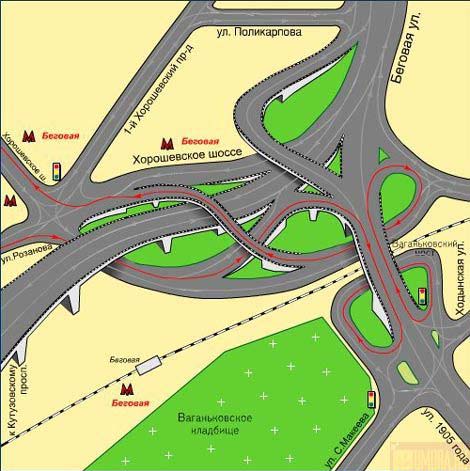
Also check out the Moscow people watching post.
Dutch bike culture
On the VACC listserv today, Gregg Sayer posted a great article on bike culture in the Netherlands. Small-wheel bikes are clearly the thing of the future out there – he’s got some great pictures of cargo bikes. Check it out, and see some photos of an eight-man cycling beer machine.
Gregg Sayer’s blog.
Sustrans talks galore, and the story of the Cheonggyecheon River
It’s been an eventful two weeks. A ton of urban conferences hit Vancouver: the World Urban Form, the Canadian Institute of Planners Congress, and Planners4Tomorrow.
Enrique Peñalosa gave an inspiring talk about his time as the mayor of Bogotá, Colombia. In a city where less than 20% own a car, why was so much downtown space devoted to automobile movement and parking? He helped institute policies enforcing sidewalk parking bans and limiting automobile access to the downtown. He rejected a Japanese consortium’s $5 billion freeway plans, and instead built a Bus Rapid Transit system similar to the one in Curitiba, Brazil. He built major bikeways, and the city has seen cycling mode share go from 0% to 6% in under ten years. Once people feel safe biking, they’ll do it.
The idea that banning cars can be democratic is interesting, but not very relevant in a Canadian context. In fact, the opposite argument could be posed: non-auto ridership is under 20% in most cities. However, in Bogota the issue was not that car drivers were in the minority, but that they consumed a disproportionate amount of public space and resources. Transit riders in Canada may be in the minority, but they save public money and space. I did read a British report from the 1960s (Traffic in Towns) that anticipated the problems when car drivers reach a majority of the population. British planners could see what had happened in the USA when car ownership passed that threshold. They were rightly concerned about the political difficulty of slowing motorisation once car owners were in the majority. But they didn’t find any way to stop it.
Peter Newman and Jeff Kenworthy were in town last week, and they gave independent talks on the same day. They’re famous for sparking a debate on the relationship between city density and fuel use per capita. After studying several North American, European, Australian and a few Asian cities, they found that there was an inverse relationship between fuel-use-per-capita and urban density. This sounds uncontroversial to the lay person – if things are closer, people need less gas to get around, or they can walk or use transit. However, it sparked a massive debate in the planning world. I’m mostly in their camp, although I’m still skeptical about some of the policy conclusions they’ve drawn. See some of my notes if you’re interested.
Both of them highlighted one fascinating story: the Cheonggyecheon River in Seoul, Korea. The photos on the right show the situation “before” (2003) and “after” its recent reconstruction in 2005. You see that correctly: twelve lanes of traffic (eight below, and four above) were replaced by four lanes, and the river that had been buried beneath in the 1940s was “daylighted” once again. Bridges across the river were rebuilt, changing the barrier expressway into a regular road. Cheap? No, it came with a price tag near US$900 million, although it’s expected to attract about US$12 billion in investment in the surrounding area. Still, a beautiful way to remake a city. Imagine a similar project on the Gardiner Expressway in Toronto, allowing the city to reach its neglected and disconnected waterfront…
GO Transit
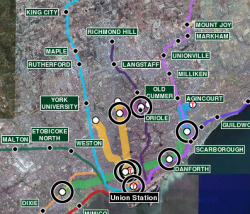
I’ve been reading Steve Munro‘s blog lately, as he discusses the nitty-gritty details of transit planning in Toronto. He brought up an interesting point regarding the extension of the Spadina subway line to York University: there’s already a GO transit line that goes direct from York University to downtown, and GO is a better way of feeding people into the downtown than the subway line. (The Yonge line is already at capacity now.)
So what about GO? I’ve only used it once or twice, and I really didn’t know much about it. I didn’t even have a picture of the network. So, I added the routes to my Toronto transit map. It was an interesting exercise – I’d never thought of Dundas West or Leslie subway stations as interchanges, but they are. You get a different view of the connectivity of the city this way – Agincourt is surprisingly close to downtown (a 27 minutes ride), the Danforth station near my parents’ house is only 11 minutes from downtown, and York University is only 22 minutes from downtown. Living in downtown without a car, there are routes to take you a huge distance from Toronto: Bradford, Milton, Hamilton, and Oshawa are all in reach. If you combined GO with a bicycle, you could get to Lake Simcoe or tour the rural areas around Toronto.
The problem, however, lies in the frequency and the hours of operation. Most of those trains only serve one-way peak hour travel, so you can’t use them for a daytrip from downtown to the hinterlands. And they run so infrequently that you would rarely choose them as an alternative to the subway. As Steve Munro suggests, we really need upgraded service on the GO lines. I’d love to see a service like Lausanne offered, with trains in every direction at reasonable frequencies.
I think it’s interesting that GO is so absent from the lives of Toronto residents. As a local, I was completely oblivious to that network – mostly, I guess, because it was nearly useless to me with its present service levels. It doesn’t even show up on TTC maps, which further marginalizes it. My only awareness of GO was where the tracks disrupted my bike ride, like the dip under the tracks on Woodbine. And yet, it could be a valuable part of carfree life in the city.

